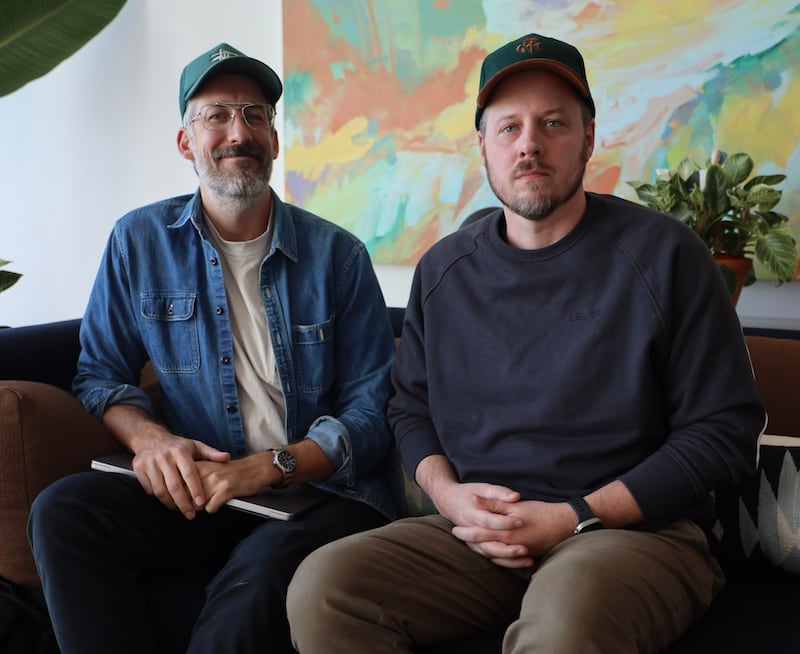This story appears in the February issue of Utah Business. Subscribe.
A turquoise-painted arrow points directly to an unlabeled button on the wall of Pluralsight’s Draper, Utah, headquarters. It looks serious and mysterious. Does it call security? Does it summon customer service? Does it open a trap door?
No. It names your company.
In 2003, four software developers were poised to launch a new tech skills company. They didn’t know much about marketing but wanted their company name to sound like the tech giants they loved—Microsoft, Autodesk, Counterpane, etc.
They noticed a formula: none of those names had an obvious meaning, they were all unique, and they each combined a two-syllable word with a one-syllable word.
If you’re a software developer with a problem and you’ve defined a formula to solve it, the next logical step is to write a program—and that’s exactly what they did.
“The program basically pulled words out of a dictionary—two-syllable words and one-syllable words—stuck them together and then did a Google search to ensure there were zero hits,” says Aaron Skonnard, co-founder and CEO of Pluralsight.
Skonnard and his co-founders sifted through all the generated names and highlighted the ones they liked. “Once we found Pluralsight, … we could see how we could layer meaning on top of the name,” he says. “The name conjured up these ideas of a plurality of insights into tech … [with] all these instructors and authors who were experts across many different fields.”
Today, that same computer program powers the mysterious button on the wall, and anyone can stop by to generate a company name in a matter of seconds. With the emergence and accessibility of AI tools, budding entrepreneurs may soon have equally smart results on their own computers—if they load their prompt with good naming fundamentals.
Naming fundamentals
Chris Crosby and Chris Mann are the co-founders of Goal, a design and branding agency that has created some of Utah’s most magnetic company names—like Album VC, Ember, Podium and Storied.
Often, clients approach Goal when they have entered a growth stage and realize they have outgrown their company name. Their name might be so specific that it precludes expansion, or they may have grown large enough to attract a cease and desist letter from a trademark holder. Whatever the case, after an organization has invested millions of dollars in building equity around a single name, the prospect of renaming the company can be distressing.
“It’s not like naming a child,” Mann says. “It’s way, way, way harder.”
Goal’s naming blueprint starts with conducting a competitive audit, outlining brand positioning and creating brand name criteria. What will feel timeless? What should the brand’s personality be? What will not cause a distraction from the company?
Next, Goal generates name options—at least 500 of them. Crosby says this is where the most common mistake occurs in naming a company: People tend to brainstorm names one at a time and vet them for availability along the way. This back-and-forth breaks momentum and extinguishes the creative spark.
Instead, Crosby recommends a solid brainstorming session before checking even one name’s availability. “The vetting phase is a bloodbath, and it always will be,” he says. “If you’re not bringing a long list to the vetting phase, … you’ll get stuck there.”
Finally, Goal’s vetting phase includes trademark reports, common-law and online usage screening, web domain availability, international linguistic checks, surveys in target geographies and cultural or existing brand associations.
Decisions are the worst
After going through the entire naming process and landing on a final option, it can still be difficult for companies to commit to a new name. Crosby says that’s completely normal. “There is no perfect brand name that descends from the heavens,” he says. “Every name—even if it’s ownable—has some trade-offs.”
For example, Crosby gives high marks on branding effectiveness to Lucid, Purple and Vivint but recognizes they had challenges in the beginning. Abstract, suggestive or coined names like these require more money and time investment to build customer brand awareness than descriptive names like The Container Store.
Instead of worrying about missing out on the perfect name, Crosby says to simply commit. If there’s nothing offensive about the name, the team likes it, and it’s ownable, it may be perfect enough.
“Six, 12 or 24 months from now—after we’ve built some memories around the name and created a visual identity around it—then it’s going to seem as if it was meant to be,” Crosby says.
In fact, sooner than you can imagine, the second choice from a list of naming options will start to feel foreign. Today, it’s hard to imagine that the Pluralsight founders almost selected “SnowCadence” as their company name 20 years ago. That name is still available, by the way, and Skonnard says any company is welcome to adopt it.



